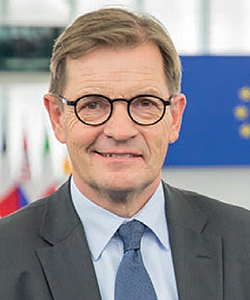 With the European
Parliament's adopted
position on the revision
of the Directive for
Energy Performance of Buildings
(EPBD), we have paved the way for
improving the energy efficiency of our
buildings in Europe.
With the European
Parliament's adopted
position on the revision
of the Directive for
Energy Performance of Buildings
(EPBD), we have paved the way for
improving the energy efficiency of our
buildings in Europe.
We spend roughly 90 per cent of our
time indoors, however, according
to a recent study1, 97.5 per cent of
our building stock in Europe can be
considered energy inefficient. Keeping
in mind that buildings consume 40 per
cent of the total energy consumption
in the EU, it does not take much
attention to realise that buildings hold
the key to delivering cost-efficiently on
our international climate commitments.
And it comes with many added
benefits such as lower energy bills,
better living and working conditions,
improved health, and jobs creation
and growth in the building sector.
As rapporteur for the EPBD revision,
I am thankful that my colleagues in
Parliament share the ambitions to fulfil
this potential. I am very satisfied that we agree to focus on tools to boost
renovations, supporting infrastructure
for electrical vehicles, and improved
monitoring of buildings’ energy
performance. Delivering on our
promises to the European public and
achieving a real boost in renovation
is now in the hands of the Member
States, as the result on the ongoing
negotiations depends on the Member
States’ willingness to commit. From
Parliament’s side we are ready to make
progress.
BOOSTING RENOVATIONS
Since new buildings are constructed
at a rate of roughly one per cent a
year, the revision of the EPBD mainly
focuses on improvements to existing
buildings. Member States simply
must show that priority is given to
addressing market failures that today
hamper renovations.
The tool for this is the long-term
renovation strategies, giving a clear
political signal that we prioritise a
better building stock, and it providing
investor certainty. Security for investors
is decisive, since public money cannot
deliver solely on their own. Public
money is a good tool to gear private
financing for renovations and can
take off part of the risk for investors.
Energy efficiency is a sure investment,
the interest rate is low and private
investors are looking for long-term
stable investments, so we must strike
now to allow the available capital to
reach the market.
ELECTRO-MOBILITY
Another cornerstone of the EPBD, is
the proposal to use the directive to
drive the roll out of infrastructure for
electro-mobility. While one could - with
good reason - question the relation
between transport requirements and
buildings, there are two reasons for
linking electro-mobility with energy
efficiency in buildings: Clearly, for
cost-efficiency, it is profitable to
incorporate expansion of infrastructure
for electro-mobility when renovating
buildings. Secondly, buildings must
be seen as a part of urban planning
and infrastructure in general. Citizens
generally pay little attention to whether
their parking spaces are considered
buildings policy or transport policy.
From Parliament’s side, we have
focused on fine-tuning the
Commission’s proposal - with the
aim at safeguarding the incentives
to renovation by requiring mainly
affordable basic such as pre-cabling
and pre-tubing. Since electricity
companies have a vested interest in
rolling out recharging points, I trust
the market to meet the expected
demand in this regard - including by
providing a future-proof approach
to the technological development. I
believe that we have found the right
balance between costs, ambitions and
incentives to renovate this way.
MONITORING ENERGY PERFORMANCE
Another way to improve our building
stock is through improved monitoring
and use of smart technologies. This
is a low-hanging fruit in the energy
efficiency efforts. Therefore, we in
Parliament propose that Member
States realise this potential by
requiring building automation
and control systems in larger nonresidential
buildings. This simple tool
would enable significant savings, while
holding short payback periods.
STATUS ON NEGOTIATIONS
The Parliament stands broadly united
behind the position adopted by the
committee in early October, and with
the significant support expressed by
stakeholders, it provides a clear signal
for improving the energy efficiency in
buildings. I truly hope that Member
States are ready to show a similar level
of commitment to provide healthier,
safer homes, and lower energy bills for
Europeans, while cutting CO2 emissions
and ensuring a sustainable and
reliable energy supply for the future.
1. Carried out by BPIE - http://bpie.eu/publication/97-of-buildings-in-the-eu-need-to-be-upgraded/